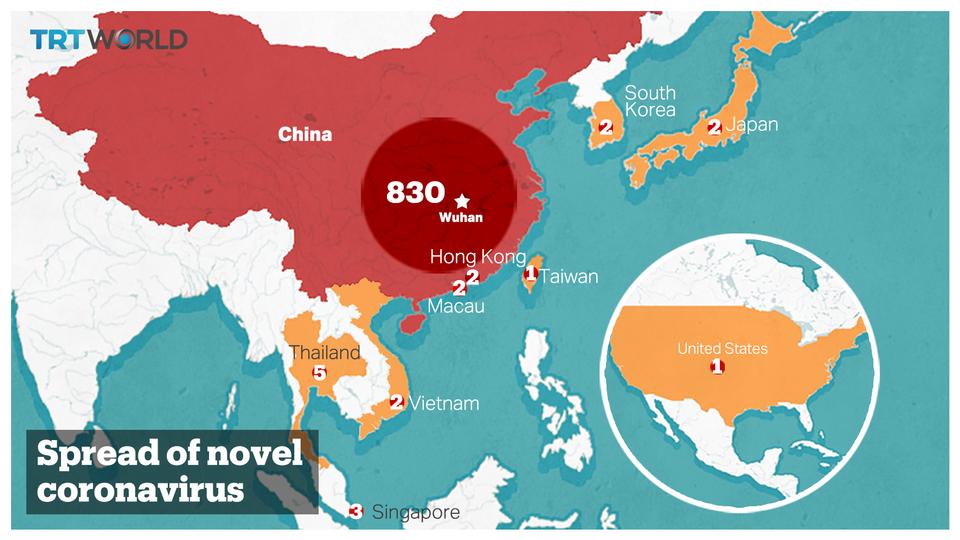The transport and public space restrictions now encompass some 40 million people as the 2019-nCoV spread to some 10 countries. There are over 800 confirmed cases in China alone.
China’s bid to contain a deadly new virus by placing cities of millions under quarantine is an unprecedented undertaking but it is unlikely to stop the disease spreading, experts warn. At least 26 people have died after contracting the 2019-nCoV or novel coronavirus.
The contagious virus has already reached elsewhere in China and abroad, and even an authoritarian government has only a small timeframe in which trapped residents will submit to such a lockdown, they say.
“I think we have passed the golden period of control and prevention,” said Guan Yi, an expert on viruses at Hong Kong University.
China on Friday added the eleventh city to a transport ban around Wuhan, the epicentre of a deadly virus, bringing the number affected by the shutdown to over 40 million as authorities scramble to control the disease.
However, with the death toll at 26 and infections being detected as far away as the US, there are fears the exercise is too little too late.
Yi, who returned from Wuhan just before the lockdown, pointed out huge numbers of people would have already left ahead of the Lunar New Year holiday, which began on Friday.
They could have been incubating the virus “on their way out of Wuhan”, he said.

Symptoms could take several days to emerge – effectively seeding a health time-bomb across the country and abroad.
While the World Health Organization held off on declaring a global emergency despite confirmed cases in half a dozen other countries, China also cancelled some Lunar New Year celebrations to prevent the disease from spreading further.
The virus that emerged in the central city of Wuhan has now infected 830 people, the national health commission said. It has spread to 10 other countries.
The new virus has caused alarm because of its similarity to SARS (Severe Acute Respiratory Syndrome), which killed hundreds across mainland China and Hong Kong in 2002-2003.
The WHO said China faced an emergency but stopped short of making a global declaration that would have prompted greater international cooperation, including possible trade and travel restrictions.
Spread of the 2019-nCoV
Singapore confirmed two more cases of a new strain of coronavirus, its health ministry said on Friday, a day after identifying its first case of the infection that originated from China.
The ministry said it expected more imported cases because of high travel volume from China. Singapore’s tally of confirmed cases is now three.
Singapore’s prime minister said on Friday that the city-state was well prepared to tackle the Wuhan flu virus, adding that it did not appear to be as deadly as the 2003 Severe Acute Respiratory Syndrome (SARS) pandemic.
“We are well prepared because we have been gearing up for such a situation ever since we dealt with SARS in 2003,” Lee Hsien Loong said in an annual Chinese New Year speech.
“MOH (Ministry of Health) has now activated plans to counter the spread of the virus, which so far does not appear to be as deadly as SARS was.”

‘No global crisis’
The National Health Commission said that of the 830 cases in China so far, 177 are in serious condition. Authorities were also examining 1,072 suspected cases.
“This is an emergency in China, but it has not yet become a global health emergency,” WHO chief Tedros Adhanom Ghebreyesus told reporters after two days of talks in Geneva.
Tedros hailed China’s preventive measures but expressed hope that they would be “short in their duration.”
Beijing has been praised for its response, in contrast to SARS, when it took months to report the disease and initially denied WHO experts any access.
Authorities have said most fatalities were aged between 36 and 89 and already suffered from pre-existing health conditions.
The youngest fatality, a 36-year-old man in Hubei, was admitted to the hospital earlier this month after suffering from fever for three days. He died following a sudden cardiac arrest on January 23.
Xiaogan, Chibi, Xiantao, Zhijiang, Qianjiang, Xianning, Huangshi, Enshi, Huanggang, Ezhou city, Jingzhou all have some level of travel restrictions imposed on their millions of residents.
Wuhan building 1,000-bed hospital
Wuhan, a major industrial and transport hub of 11 million people in the centre of the country, has been rendered a ghost town by China’s imposition of an unprecedented transport quarantine around it and nearby cities.
China has begun its Lunar New Year holiday, typically marked by family gatherings and public events, but the streets of Wuhan were deserted and stores shuttered.
Even the police presence, usually prominent in China, was hardly detectable.
Wuhan is rapidly building a new 1,000-bed hospital to treat victims of the new coronavirus, mobilising machinery to get it ready by early next week, state media said.
The new hospital is being built around a holiday complex originally intended for local workers, set in gardens by a lake on the outskirts of the city, the official Changjiang Daily reported on Friday. Prefabricated buildings which will have 1,000 beds will be put up, it said.

Building machinery, including 35 diggers and 10 bulldozers, arrived at the site on Thursday night, with the aim to get the new facility ready by Monday, the paper added.
“The construction of this project is to solve the shortage of existing medical resources,” the report said. “Because it will be prefabricated buildings, it will not only be built fast but it also won’t cost much.”
To discourage nationwide travel, the government said on Friday that all tickets for rail, air, road, or water transport could be exchanged for a full refund.
Beijing has cancelled massive gatherings that usually attract throngs at temples during the New Year holiday, while the historic Forbidden City will close from Saturday.
The respiratory virus emerged from a seafood and animal market in Wuhan in late December.





